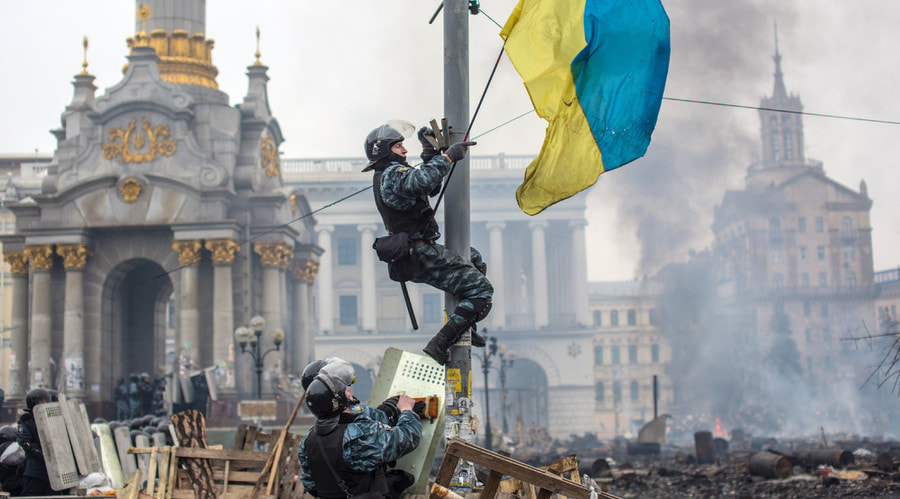|
Russia’s war on Ukraine did not begin on 24 February 2022. Its roots go much deeper, extending back a whole decade, to the last weeks of 2013. Ukraine’s then-president, Viktor Yanukovych had for many months been following a policy of ‘walking towards Europe’. But just at the moment when he was due to sign an agreement with the European Union aimed at forging closer ties, he got cold feet.
The reason for the about-turn? Vladimir Putin. With promises of cheap gas and advantageous trade arrangements through his new Eurasian union, the Russian president persuaded Yanukovych to turn his back on Europe in favour of deeper ties with Russia. On 21 November 2013, the government announced that it was shelving the EU agreement. Outraged students and young people gathered in Kyiv’s Independence Square, known as the Maidan. They waved EU and Ukrainian flags. They sang Ode to Joy – the anthem of the EU – and Ukraine’s national anthem, with its prophetic opening words: Ukraine has not yet perished. They stayed late into the night and their numbers swelled. By the end of November, their cause seemed lost, the impetus for continuing the protest was waning. But everything changed on the night of 30 November. Riot police stormed the square, firing teargas and beating up the students with truncheons – metal truncheons. Beating them hard enough to break bones. The attack was intended to scare the protestors away and put an end to the demonstrations, but they had precisely the opposite effect. Had Yanukovych not sent his riot police into the Maidan that night with orders to clear the square at any cost, Ukraine could be a very different place today. No full-scale invasion, no Russian republics in the Donbas, no annexation of Crimea. It’s impossible, of course, to turn back the clock to pivotal moments in history and know what would have happened if events had played out differently. My guess is that Ukraine and Russia would have continued to coexist in an uneasy peace, the leadership in Kyiv at times veering towards Europe, then being pulled back towards Moscow. Instead, hundreds of thousands of Ukrainians came out onto the streets in protest at the heavy-handed action of the riot police. The students’ outraged parents joined the demonstrations. Pensioners, mothers with toddlers in pushchairs, tradesmen, ex-soldiers, teachers, doctors – the whole gamut of Ukrainian society rose in outrage. The protest was no longer just about European integration, but about police aggression, corruption, values, morality. In early December, the area around the Maidan transformed into a tent city, a camp of makeshift shelters, complete with a stage and barricades, decorated with flags and banners and slogans. The protestors established kitchens to provide food, medical facilities, book exchanges, donation centres for provisions. They took control of buildings around the Maidan where protestors ate and slept and got respite from the cold. And night after night, they burned tyres and waged war with the riot police. Armed with baseball bats, fireworks and Molotov cocktails, and dressed in balaclavas and bicycle helmets, the anti-government activists pitched themselves against trained squadrons firing tear gas, stun grenades and watercannon. What started as a peaceful student protest within a few weeks had turned into an uprising, a revolution. The nightly clashes reached a climax in February 2014, when police began firing live ammunition. Snipers shot and killed dozens of protestors in a massacre that is still the subject of competing narratives of blame, and whose perpetrators have never been brought to justice. In total 107 activists were killed during the Maidan revolution – nearly half of them during the massacre of 20 February 2014 – and 13 police officers. Today the fallen heroes of what has become known in Ukraine as the Revolution of Dignity are remembered as the Heaven’s Hundred. With Ukraine reeling from the horrors of the massacre, Yanukovych fled, leaving Kyiv in a state of chaos and the country rudderless. Putin was rubbing his hands in glee. Moscow was already widely believed to have infiltrated the Maidan, carrying out ‘false flag’ operations and aiding the government’s forces. As soon as the revolution was over, Putin made his next move: preparations for the annexation of Crimea and violent uprisings in the industrial Donbas regions of Donetsk and Lugansk that would rumble on until the full-scale invasion began, leaving around 14,000 dead and displacing millions of civilians.
0 Comments
|
Keeping stories aliveThis blog aims to discuss historical events relating to the Jewish communities of Ukraine, and of Eastern Europe more widely. As a storyteller, I hope to keep alive stories of the past and remember those who told or experienced them. Like so many others, I am deeply troubled by the war in Ukraine and for the foreseeable future, most articles published here will focus on the war, with an emphasis on parallels with other tumultuous periods in Ukraine's tragic history. Archives
March 2024
Categories
All
|

 RSS Feed
RSS Feed
